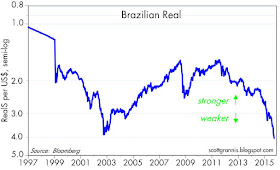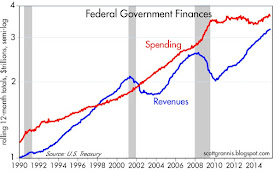There's a meme running around that says that deflationary pressures are so acute (think falling oil and commodity prices, coupled with cheap Chinese imports) that the Fed is almost powerless to get inflation up to its 2% target and therefore they would be crazy to start raising short-term interest rates.
I think the current level of inflation (approximately 1.5% if you look at a variety of indicators) is just fine, and I wouldn't mind at all if it were a bit lower. In fact, zero sounds right to me, because I have never understood why 2% is ideal and zero is not. Inflation—no matter how low or high—is insidious; it robs the poor and ignorant, while benefiting governments and the financially astute. It transfers wealth from the private sector to the public sector, with the bulk of the wealth confiscation coming from savers and the uninformed. Governments (and their complicit partners, central banks) create inflation, and—surprise, surprise—governments are the major beneficiaries of inflation.
Regardless of what you think the ideal rate of inflation is, the real problem is figuring out how to measure it.

The mathematicians at the BLS face the daunting task of figuring out just how much prices for personal computers have declined over the years, given that their speed, memory, and capabilities have multiplied by orders of magnitude. How am I to compare what I spent in today's dollars on my first Mac SE in 1987? I paid about $2700 for it, but it had a small black & white screen, 1 MB of RAM, and a 20 MB hard drive. It talked to the internet at snail speed, and it took hours to back up the hard drive to floppy disks. For $2500 today, I can buy a MacBook Pro that is so much more powerful you'd think it came from a parallel universe: 16 GB of RAM, 512 GB SSD, 9 hour battery, and a 15" screen that rivals a National Geographic photo. It can download terabytes of data in the time it took my Mac SE to back up a few floppy disks. To make matters worse, today's laptop can perform functions (like editing full-length HD movies) that weren't even possible in 1987.
How can
hedonic pricing figure this out?
As the chart above shows, the BLS has made a good faith effort to resolve this seemingly impossible task. They figure that a dollar spent on personal computers in 1998 is equivalent to about 4 cents today. In other words, they figure that the prices of personal computers and peripherals (which comprise only a few percentage points of the overall CPI index) have dropped by almost 96% since 1998 (nominal prices haven't dropped all that much, but the bang for the buck has been gigantic). The BLS is telling us that personal computers are almost 24 times more powerful today per dollar than they were just 17 years ago. I'm not sure that's correct, but then I don't think anyone knows the right answer. How important a role should the massive deflation of personal computers alongside their huge technological advances play in the overall CPI index? It's transformed society and the way we work and communicate with each other. What we take for granted today was not even possible at any price in 1998. Maybe computers have effectively fallen even more in price, and/or they should have a larger weight in the CPI.

But it's not just personal computers that have fallen in price. As the chart above shows, the BEA calculates that the costs of durable goods in general (e.g., TVs, cars, computers, appliances) have fallen by 32% on average since 1995. Meanwhile, the costs of just above everything else have been rising. (I chose 1995 as the start date for this chart since that is the first year in history that the prices of durable goods fell even as other prices rose. It's also not a coincidence that 1995 was the first year that China started exporting cheap goods to the U.S. in a serious fashion.)
Consider that the "Services" index in the above chart is a good proxy for personal incomes (both have risen by approximately the same amount since 1995). What this means is that durable goods have become very cheap relative to incomes in the past 20 years. One hour's worth of income today now buys almost two and a half times more in the way of durable goods than it did 20 years ago. Wow.
Is it a bad thing when our wages allow us to buy more of the things that enrich our life? If durable goods deflation is good, why should falling prices of other things be bad?
In any event, the falling prices of durable goods have to some palpable degree contributed to lowering the rate of inflation that we all have experienced. China gets the bulk of the credit, since China figured out how to transfer hundreds of millions of workers from the countryside to modern factories. A substantial portion of the world's workforce became dramatically more productive in a relatively short timeframe, and this resulted in a huge increase in the productivity of the average human being on this planet. More productivity in China has resulted in higher living standards for everyone. Progress of this sort is most definitely NOT a zero-sum game. (Donald Trump, call your office!)

When sharply lower oil prices (down by more than 50% since the summer of 2014) are factored in to the inflation indices, the result is lower headline inflation. But there's nothing wrong or sinister about that, is there? Cheaper computers, cheaper gasoline, it's all the same: our dollars go farther and our living standards rise. It's times like this when we have to look at "core" inflation, which factors out food and energy prices. As the chart above shows, the core rate of inflation according to the PCE deflator is 1.3% in the 12 months ended August, while the headline rate is a mere 0.3%.

But if we look at the annualized rate of change in both the indices over the past six months, the picture changes significantly. As the chart above shows, headline inflation by this measure is 1.8% and the core rate is 1.6%—pretty close to high end of the Fed's target. Oil prices are no longer falling, and the dollar has been relatively stable for the past six months. Maybe the CPI over the past six months is giving us a better reading of underlying inflation than most people realize.

As the chart above shows, the headline CPI is running at a 2.3% annualized rate over the past six months, and the core rate is running just over 2.0%. The ex-energy version of the CPI is up at a 1.9% annualized pace over the same period. Put all these together and I think it's safe to say that inflation today is at least 1.5%. How this presents a problem to anyone outside of the energy and computer industries (Apple's profit margins are still huge, by the way) I just don't know. Why it should keep the Fed from raising interest rates by a puny 0.25% I fail to comprehend. Shouldn't the Fed be forward looking?





















































